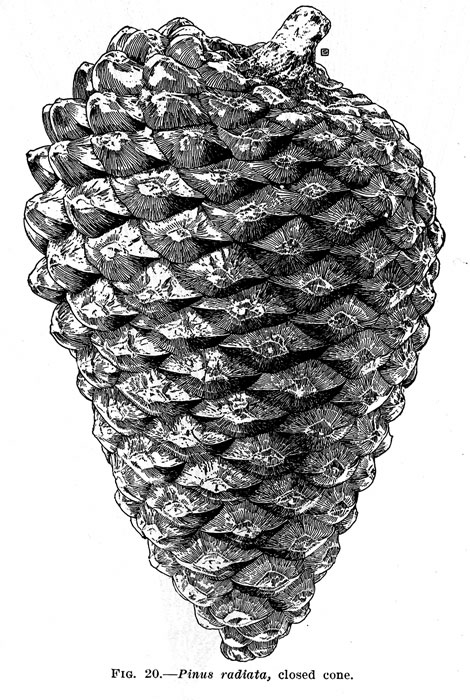Pinus radiata
 Monterey pine
Monterey pine

Needles are in threes about 5 inches long, and the cones are about the same length and noticeably asymmetrical in attachment to the branch. The asymmetry is associated with dwarfing of the base scales on the side to which the cone leans. Monterey pine grows in two patches just south and just north of Monterey Bay, near Cambria a little farther south, and on some of the offshore islands. It is never more than about 3 miles from the sea or far from sea level except on Guadalupe Island off the coast of Baja California, where it grows between 2000 and 4000 feet. It was formerly used as lumber in California but became very popular for landscape use. Monterey pines are all over the campus, many exhibiting signs of distress such as dieback, fungus, borers, whose depredations were already noted in 1927, and massive pitch exudations: Serra Street near the Hoover Tower, Serra Street between Pampas Lane and El Camino Real, and Campus Drive East alongside Pearce Mitchell Houses.
In spite of its modest impact in its native environment, it has come to be a most important tree for timber production in New Zealand, Chile, Australia, and South Africa, where it is free from insect pests. The dark, regularly spaced pine plantations are, as a result of the absence of insects for food, rather eerie places: there are no spiders, no birds, and no insectivorous mammals in the exotic forests. Plantations are thinned two or three times providing saleable wood chips and poles, and felled at 40 years for sawn timber, particle board, and paper production.
Foresters found pine pitch canker (Fusarium circinatum) in California in 1986 in New Brighton Beach. The disease quickly spread to native pines along the coast, with the Monterey pine being the most widely affected host. Native Monterey pines exist only in three small groves in Santa Cruz, Monterey and San Luis Obispo counties and are seriously threatened. Widespread plantings of ornamental Monterey pine in the Bay Area are also severely impacted. In 2004, pitch canker was discovered in Douglas fir in the Sierra Nevada. There is no effective control of pitch canker currently available. (David L. Wood, PhD, Cafe Scientifique Silicon Valley)
Name derivation: Pinus – the Latin name; radiata – radiating (perhaps relating to the whorls of cones about the branches).
About this Entry: The main text of this entry is from the book Trees of Stanford and Environs, by Ronald Bracewell, published 2005. John Rawlings added the paragraph from David Wood.



